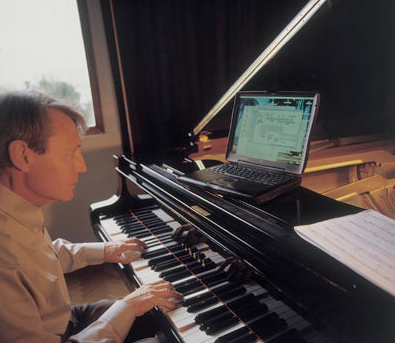Keynote 1: Jean-Claude Risset
CNRS-Laboratoire de Mécanique et d'Acoustique
Tuesday, October 15th - 10:00
Video recorded and edited by Olivier Derrien.
Download the text of Jean-Claude Risset conference (pdf 160.4 Ko)
 Composer and researcher. Born 1938, France.
Scientific and musical studies (Ecole Normale Supérieure, piano, composition with André Jolivet).
Worked at Bell Labs with Max Mathews in the sixties to develop the musical resources of computer sound synthesis (trumpet simulation; pitch paradoxes; synthesis of new timbres; sonic developpement processes; sound catalog of synthesized sounds, 1969).
Head of Computer Department at IRCAM (1975-1979).
At M.I.T. Media Labs, develops from 1989 the first « Duet for one pianist », whereby the pianist triggers an accompaniment on the same piano that depends upon what and how he or she plays.
Emeritus at CNRS, Laboratoire de Mécanique et d’Acoustique, Marseille.
For his pionnering work in computer music, he received notably the first Golden Nica (Ars Electronica Prize, 1987), the Giga-Hertz-Grand-Prize 2009, and the highest French awards in both music (Grand Prix National de la Musique, 1990) and science (Gold Medal, Centre National de la Recherche Scientifique, 1999).
Composer and researcher. Born 1938, France.
Scientific and musical studies (Ecole Normale Supérieure, piano, composition with André Jolivet).
Worked at Bell Labs with Max Mathews in the sixties to develop the musical resources of computer sound synthesis (trumpet simulation; pitch paradoxes; synthesis of new timbres; sonic developpement processes; sound catalog of synthesized sounds, 1969).
Head of Computer Department at IRCAM (1975-1979).
At M.I.T. Media Labs, develops from 1989 the first « Duet for one pianist », whereby the pianist triggers an accompaniment on the same piano that depends upon what and how he or she plays.
Emeritus at CNRS, Laboratoire de Mécanique et d’Acoustique, Marseille.
For his pionnering work in computer music, he received notably the first Golden Nica (Ars Electronica Prize, 1987), the Giga-Hertz-Grand-Prize 2009, and the highest French awards in both music (Grand Prix National de la Musique, 1990) and science (Gold Medal, Centre National de la Recherche Scientifique, 1999).
Music: Ars Bene Movandi
According to Saint Augustinus, music is ars bene movandi – the art of moving well, a graceful dance of sounds. This statement is more than a metaphor. According to Sundberg, “our listening refers to experiences of movement”: thus “an aesthetically pleasing performance is similar to a graceful motoric pattern”.In my presentation, I shall first give various instances of the importance of motion in sound and music. The motion of most resonating bodies is not harmonic. Fast vibratory motions are perceived as pitches, while slow sub-audio modulations yield changes of amplitude. The art of musical instrument makers has to take in account the physical laws of acoustics as well as the specifics of the auditory perception to construct machines that will effectively convert the expert gestures of the performer into audible acoustic energy. There are two basic archetypes of instruments: the violin player controls his sound from beginning to end, while the percussionist, as soon as he or she has triggered a sound, can attend to the next one. Small children cannot refrain from dancing on music with a strong beat: they will not dance on periodic recurrence of images.
Then I shall demonstrate an interactive process of accompaniment I have developed in Media Lab, M.I.T. and in Laboratory of Mécanique and Acoustique of C.N.R.S. (L.M.A.), using a Disklavier, a mechanized acoustic piano built by Yamaha. This is a special interaction, in which the key motions of the pianist trigger a response in terms of motions of mechanical keys rather than motions of a loudspeaker membrane: the live pianist is accompanied by a virtual partner playing on the same piano an accompaniment which depends on what the pianist plays and how he or she plays.
Webpages
IRCAM’s ‘Brahms’ Data Base : " Jean-Claude Risset " (realized by Vincent Tiffon),also http://jcrisset.free.fr/ (incomplete)
Video Downloads
Videos were recorded and edited by Olivier Derrien. Right-click on the link.High-Definition 1280 x 720
Quicktime video (2.95 Go)Low Definition 560 x 320
Quicktime video (131.1 Mo)MP4 video (130.1 Mo)
Ogg video (232.3 Mo)